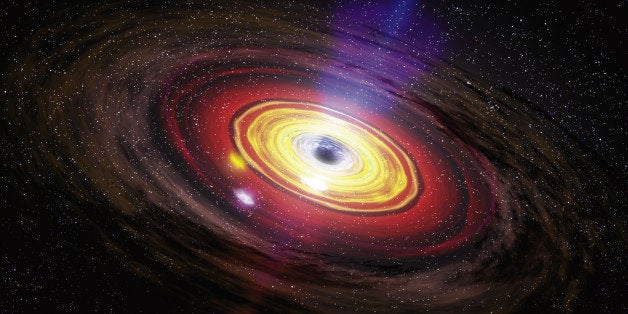
The other shoe has dropped.
After a century of speculation and a half-century of searching, science teams using instruments built by Caltech and MIT have made a discovery that will take up permanent residency in physics textbooks from now to the end of textbooks. They've found the gravity waves that Einstein's General Theory of Relativity predicted must pervade the cosmos.
There's little doubt that this experiment should be celebrated. It's a triumph of perseverance and clever effort: the instrumentation involved is able to detect distortions amounting to a millionth of a billionth of a meter in a tube four kilometers long. That's like measuring the distance to Mars with a precision greater than the thickness of a bacterium's cell wall.
Once more, Einstein's concept of space-time has been vindicated, and while pundits love to talk about how incomplete science is and how little those pointy-headed academics know, this discovery indicates that there are things we do know. Important things, such as the behavior of space and time.
This is a story about physics, of course. But although one seldom hears "extraterrestrial intelligence" and "space-time continuum" in the same breath (unless you're a Dr. Who fan), there's a perceived connection between the two subjects.
I often get correspondence from folks who think that listening for radio signals or looking for laser flashes are fundamentally flawed approaches to hunting down evidence for alien beings. The extraterrestrials, these people suggest, will have moved on to a more avant-garde communication mode: gravity waves.
There are, indeed, some positive arguments for aliens with a penchant for palaver to opt for gravity wave communication. Gravity waves can travel unhindered through the dusty material that suffuses interstellar space -- unlike laser light. And gravity waves aren't distorted and scattered by the ionized gas that clutters the cosmos -- unlike radio waves.
In addition, you don't have to aim your gravity wave detector in any particular direction: the waves go right through the Earth and reach you from everywhere.
But alas, there's a serious downside.
The gravitational disturbance that produced this history-making detection was apparently the result of two colliding black holes. That's not something you see every day. Yes, gravity waves are ubiquitous: they're generated as the Moon orbits the Earth or for that matter whenever you wave your arms. But even the extremely sensitive instrumentation of LIGO (the Laser Interferometer Gravitational-Wave Observatory) is thoroughly unable to pick up these very local disturbances. It took a rare cosmic catastrophe to produce a space-time ripple large enough to be sensed.
So imagine a scenario in which every time you want to send a bit of information to another part of the universe, you have to slam together a pair of black holes. Not easy, and not cheap -- especially if your goal is to send lots of information.
Also, many people (including, it must be said, Isaac Newton) have assumed that gravity waves travel at infinite speed. That would be a real plus for using them to communicate across the vast distances of the cosmos. But it's not true: they travel no faster than light and radio. If the Sun were to evaporate right now, Earth would continue to orbit its ghost for another eight minutes before barreling in a straight line towards the galaxy's nether regions.
Gravity waves may not be the communication mode of choice for intelligent beings, but they will eventually give us an entirely new way to study the cosmos, including its earliest history. That's a real promise.
Meanwhile, there's this philosophical uplift: Gravity waves have been as elusive as the Higgs boson, dark matter and dark energy. But they're another cosmic phenomenon that has just moved from the category of "blackboard conjecture" to that of "experimentally demonstrated." It's an important day.